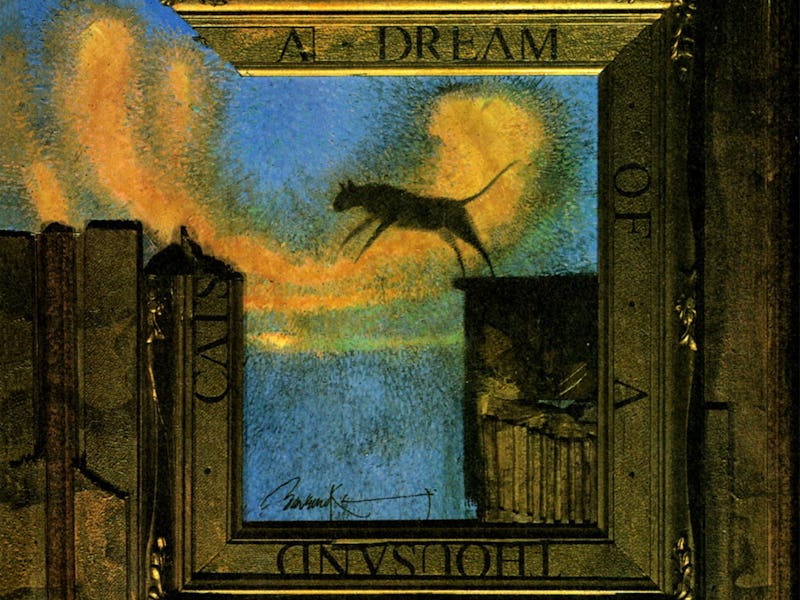Sandman Episode 11: “A Dream of A Thousand Cats” and “Calliope,” explained
Fans of Netflix's Sandman adaptation were surprised with a bonus episode straight from Volume 3 of the comics.

Your cat dreams. And according to The Sandman, those dreams aren’t as cute as you’d hope. Fans of Netflix’s Sandman adaptation were surprised Friday morning with a bonus episode only two weeks after the show’s debut.
The first half of the episode is an animated take on “A Dream of a Thousand Cats,” one of the most cherished Sandman stories. Directed and produced by Hisko Hulsing, known best for his work on Amazon Prime’s Undone, the cartoon incorporates a blend of classically drawn 2D and realistic 3D animation to create a mesmerizing and hypnotic world where felines rule men.
The episode’s second half is a live-action story directed by Louise Hooper recounting the events of “Calliope,” a ghastly story about Morpheus’ imprisoned ex-lover, the muse of eloquence and epic poetry. Hooper has previously directed two episodes of Netflix’s The Witcher.
Why are these Sandman tales important to the Netflix series? And why are they being added after the release of the first 10 core episodes? Here’s what you need to know.
The Sandman’s “Dream of a Thousand Cats” explained
Do other animals dream? Sandman says they do, and their dreams are just as important as the dreams of humans.
The voice cast of “A Dream of a Thousand Cats” is packed with star power, including Sandra Oh, James McAvoy, Nonso Anozie, David Tennant, Michael Sheen, and Neil Gaiman himself.
In the comics, a young couple’s kitten is coerced by a strange brown cat to leave the bed of her human owners and attend a speech by a feline prophet, a purebred Siamese. The speaker regales a congregation of cats with a tale of a dream she had after her cruel owners drowned her kittens in a lake.
In the Dreaming, the Siamese meets with a feline aspect of Morpheus known as The Cat of Dreams. She asks him why her owners would murder her litter, and why cats are subjugated by humans. The Cat of Dreams shows her a past in which cats were larger than humans and ruled the earth. However, the dominion of cats crumbled when the humans rebelled and followed their dream of freedom to become the superior beings.
The Siamese then tells her audience that if they all dreamt of being the rulers of Earth again, then their wish would come true. The story ends with the kitten going home and dreaming of feline supremacy.
In The Sandman, the dreams of all creatures have the potential to make or destroy the world.
A favorite among Sandman readers, “A Dream of a Thousand Cats” was likely adapted for fan-service and fan-service alone. It doesn’t advance the show’s plot, which has shifted to focus on Morpheus, his duties, and how his Endless siblings challenge or support his position as The King of Dreams. However, it does showcase the potential for dreams to manipulate and shape reality, a motif throughout the Sandman comics, and it reveals that the dreams of other species are just as powerful as the ones humans have.
The Sandman’s “Calliope” explained
“Calliope,” the live-action segment of the bonus episode, features Greek actress Melissanthi Mahut as the muse and Sir Derek Jacobi as Erasmus Fry. In 1927 Fry, a wannabe author suffering from writer’s block imprisons Calliope much like how Roderick Burgess captured Morpheus. Fry habitually rapes Calliope and justifies it with his need for inspiration. Eventually, Fry becomes a best-selling author.
In 1986, Fry sells Calliope to another writer, Richard Madoc (Arthur Darvill), in exchange for a magical bezoar with the potential to heal. Fry commits suicide once his fame wanes, while Madoc sexually assaults Calliope to improve his own creative fortunes.
This dark and disturbing Sandman story challenges the concept of women serving as muses for men.
Tired of being abused, Calliope calls on the Fates to help her seek aid from Morpheus, her ex-lover and the father of her child, Orpheus. Morpheus rescues Calliope and, to punish Madoc, curses him with an overabundance of ideas, forever preventing him from concentrating on a single story.
Unlike “A Dream of a Thousand Cats,” “Calliope” is neither charming, trippy, nor whimsical. Instead, it’s a harrowing story about the exploitation of women by male artists in positions of power, a “#MeToo” story ahead of its time.
“Calliope” also explores a theme that Gaiman returned to throughout the Sandman comics: How writers derive their ideas, and what harm they can cause with them. The story also introduces the mother of Morpheus’ child, Orpheus, who plays a role in a storyline involving the Endless siblings and Lady Johanna Constantine. If The Sandman is greenlit for future seasons, this story may begin sometime around Season 3. So while “A Dream of a Thousand Cats” was just a fun one-off, “Calliope” has consequences you should remember.
All episodes of The Sandman are streaming on Netflix.
This article was originally published on